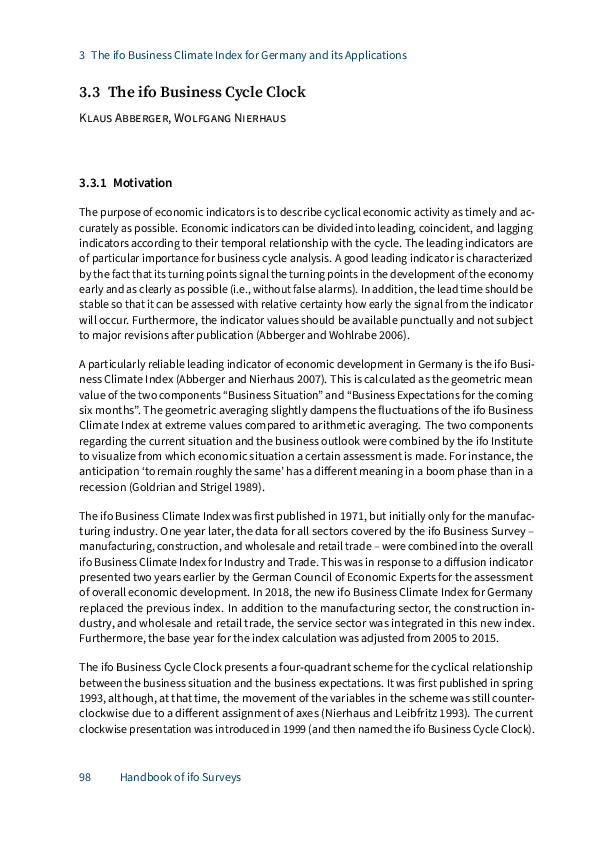The ifo Business Cycle Clock
ifo Institut, München, 2023
ifo Beiträge zur Wirtschaftsforschung / 100, 98-109

The purpose of economic indicators is to describe cyclical economic activity as timely and accurately as possible. Economic indicators can be divided into leading, coincident, and lagging indicators according to their temporal relationship with the cycle. The leading indicators are of particular importance for business cycle analysis. A good leading indicator is characterized by the fact that its turning points signal the turning points in the development of the economy early and as clearly as possible (i.e., without false alarms). In addition, the lead time should be stable so that it can be assessed with relative certainty how early the signal from the indicator will occur. Furthermore, the indicator values should be available punctually and not subject to major revisions after publication (Abberger and Wohlrabe 2006).
A particularly reliable leading indicator of economic development in Germany is the ifo Business Climate Index (Abberger and Nierhaus 2007). This is calculated as the geometric mean value of the two components “Business Situation” and “Business Expectations for the coming six months”. The geometric averaging slightly dampens the fluctuations of the ifo Business Climate Index at extreme values compared to arithmetic averaging. The two components regarding the current situation and the business outlook were combined by the ifo Institute to visualize from which economic situation a certain assessment is made. For instance, the anticipation ‘to remain roughly the same’ has a different meaning in a boom phase than in a recession (Goldrian and Strigel 1989).
The ifo Business Climate Index was first published in 1971, but initially only for the manufacturing industry. One year later, the data for all sectors covered by the ifo Business Survey – manufacturing, construction, and wholesale and retail trade – were combined into the overall ifo Business Climate Index for Industry and Trade. This was in response to a diffusion indicator presented two years earlier by the German Council of Economic Experts for the assessment of overall economic development. In 2018, the new ifo Business Climate Index for Germany replaced the previous index. In addition to the manufacturing sector, the construction industry, and wholesale and retail trade, the service sector was integrated in this new index. Furthermore, the base year for the index calculation was adjusted from 2005 to 2015.
The ifo Business Cycle Clock presents a four-quadrant scheme for the cyclical relationship between the business situation and the business expectations. It was first published in spring 1993, although, at that time, the movement of the variables in the scheme was still counterclockwise due to a different assignment of axes (Nierhaus and Leibfritz 1993). The current clockwise presentation was introduced in 1999 (and then named the ifo Business Cycle Clock). In this diagram, the business cycle – visualized as a situation-expectation graph – crosses the quadrants labelled “upswing”, “boom”, “downturn” and “recession”, provided that the expectation indicator sufficiently leads the business situation indicator. The names of the quadrants are not to be interpreted as strict classifications of the economic situation. They rather reflect the relationship between the development of the current situation and the expectations for the next months, i.e., the two components of the ifo Business Climate Index.
Enthalten in Zeitschrift bzw. Sammelwerk
Handbook of ifo Surveys
ifo Institut, München, 2023
ifo Beiträge zur Wirtschaftsforschung / 100